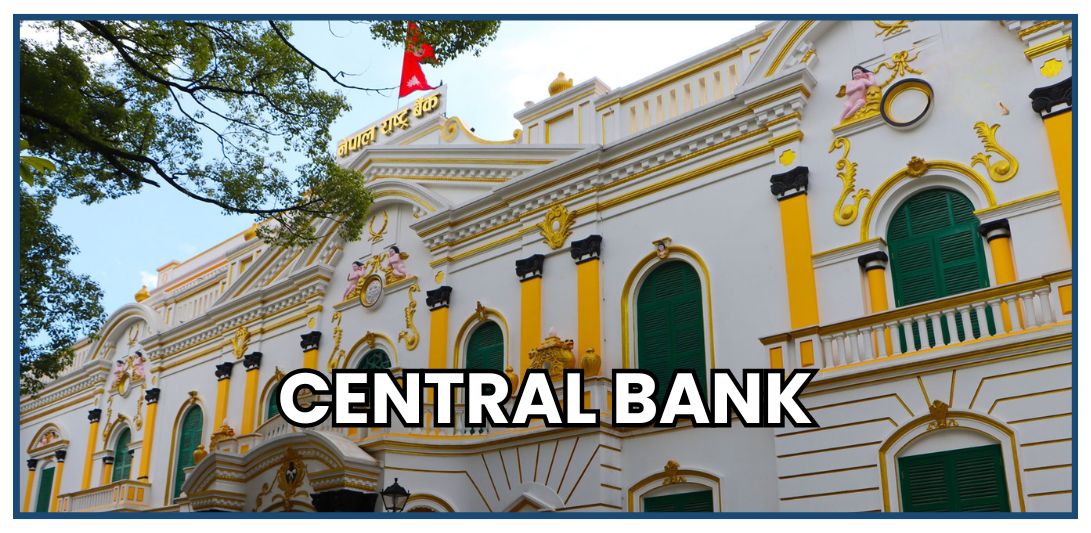A central bank is the main financial institution of a country responsible for managing money, controlling inflation, regulating banks, and ensuring economic stability. It operates independently or under government supervision to implement monetary policies that influence the economy.
What is the Central Bank?
The Nepal Rastra Bank (NRB) is the central bank of Nepal, established in 1956 under the Nepal Rastra Bank Act. Think of it as the “bank of banks”. It oversees the entire financial system, regulates commercial banks, and acts as the government’s banker. Unlike commercial banks, the NRB doesn’t serve the public directly. Instead, it works behind the scenes to ensure economic stability and foster trust in Nepal’s financial institutions.
Key Functions of Nepal Rastra Bank
- Monetary Policy Management
The NRB controls the money supply and interest rates to keep inflation in check and support economic growth. Tools like the repo rate (the rate at which banks borrow from NRB) help manage liquidity. - Currency Issuance
NRB is the sole authority to print and circulate Nepalese currency (Nepalese Rupees). It ensures enough cash is available while combating counterfeiting. - Regulating Banks & Financial Institutions
It licenses and monitors banks, microfinance institutions, and cooperatives to ensure they operate safely and ethically. - Foreign Exchange Management
NRB manages Nepal’s foreign reserves, sets exchange rates, and facilitates overseas trade and remittances. - Government’s Banker
NRB handles the government’s accounts, manages public debt, and advises on economic policies.
Major Roles of NRB in Nepal’s Economy
- Economic Stability: Uses policies to balance inflation, employment, and growth.
- Financial Inclusion: Promotes access to banking services in rural areas through microfinance and digital banking.
- Payment Systems: Ensures smooth digital transactions (e.g., mobile banking, QR payments).
- Crisis Management: Intervenes during financial crises (e.g., COVID-19 relief measures).
History of the Central Bank of Nepal
Nepal Rastra Bank was established in 1956 as Nepal’s first central bank to regulate and stabilize the country’s financial system. In 1985, it introduced financial reforms to liberalize the economy, encouraging private sector participation in banking. The NRB Act of 2002 granted the bank more autonomy, enhancing transparency and strengthening its role in financial regulation. In recent years, NRB has focused on digital transformation, improving banking accessibility, and promoting green financing to support sustainable economic growth.
Recent Initiatives by Nepal Rastra Bank
NRB is constantly adapting to modern financial needs. Some recent steps include:
- Digital Financial Services
Promoted apps like FonePay and Connect IPS for instant payments. - Financial Literacy Programs
Workshops to educate rural communities on savings, loans, and digital banking. - SME Support
Launched low-interest loan schemes for small businesses post-COVID. - Sustainable Banking
Encouraged banks to fund eco-friendly projects like solar energy.
Challenges Faced by NRB
Despite its successes, Nepal Rastra Bank (NRB) faces several challenges:
- Unstable Economy: Changes in global markets can impact Nepal’s economy, making it difficult to manage financial policies.
- Regulation Issues: Making sure that all banks and financial institutions follow the rules is a constant challenge.
- Technology Upgrades: Bringing in new digital banking systems while keeping them secure requires ongoing investment.
- Balancing Growth and Stability: NRB needs to support economic growth while ensuring that the financial system remains stable.
Board of Directors
As stated in the Nepal Rastra Bank Act (2002), the Board of Directors consists of seven members. The Governor heads the Board. The Government of Nepal (Council of Ministers) appoints the Governor, Deputy Governors, and other Directors for five-year terms.
Former Governors of Nepal Rastra Bank
How NRB Affects You Directly
Nepal Rastra Bank (NRB) plays an important role in shaping the financial environment for both businesses and individuals:
- For Businesses: NRB ensures a stable financial system, which helps businesses grow and invest with confidence. Predictable interest rates and well-regulated banks make it easier for businesses to plan their finances.
- For Individuals: People benefit from better banking services, secure savings, and easier access to digital transactions. NRB also works to include more people in the banking system, making financial services available to everyone.
Conclusion
Nepal Rastra Bank is more than just a central bank. Its changing roles and ongoing improvements have made it a key part of Nepal’s financial system. Understanding its functions, challenges, and impact helps businesses and individuals make better financial decisions. Whether you want to invest, save, or stay informed, NRB’s policies affect many areas of daily economic life in Nepal.
FAQs About Nepal Rastra Bank
1. Who governs the Nepal Rastra Bank?
Nepal Rastra Bank is governed by a board of directors (the Governor) appointed by the government. The board works closely with the government to implement the monetary policy of Nepal and regulatory measures.
2. How does NRB control inflation?
The NRB controls inflation by regulating the money supply, setting interest rates, and using monetary policy tools to ensure that price levels remain stable. This helps maintain the purchasing power of the currency. In other words, by increasing interest rates (to reduce spending) or decreasing them (to encourage loans and growth).
3. Can individuals open accounts at NRB?
No, NRB only works with the government and banks, not the general public.


